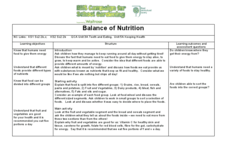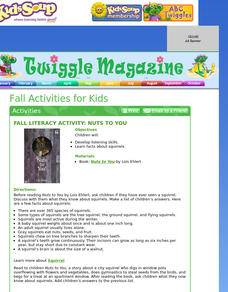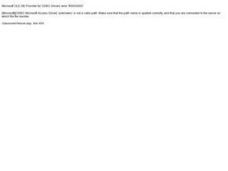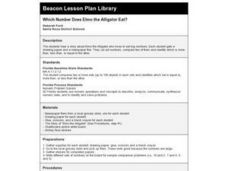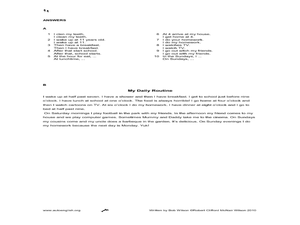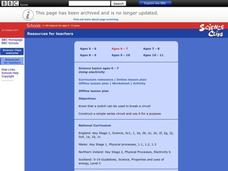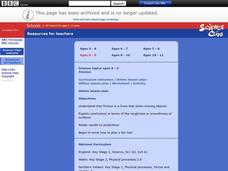Curated OER
What Animals Eat
First graders organize animals according to what they eat. They compare the teeth of plant eaters and meat eaters.
Curated OER
Module 3: "You Have the Power!"
Students explore how to maintain a healthy mouth and how to keep teeth clean. They become aware that brushing with fluoride toothpaste is helpful if done on a daily basis, flossing is important, and eating and drinking nutritious foods...
Curated OER
Balance of Nutrition
Students explore nutrition by completing a group activity. In this balanced meal lesson, students identify the five food groups and discuss their favorite foods from each group. Students utilize illustrations to fill in a fictional plate...
Curated OER
Trick or Fruit
For this health and diet worksheet, students circle all of the healthy snack choices from those given in a list on the page. They write a list of other good snacks on blank lines on the page. This worksheet is associated with the Junie...
Curated OER
Nuts About Squirrels
Early childhood students will develop listening skills as they read "Nuts To You" by Lois Ehlert. In this lesson students will learn about Students will learn facts about different types of squirrels and their behaviors. There will be a...
Curated OER
Present Time and Past Time
Review past and present tense, and then give your class this worksheet to assess their current knowledge. There are 30 sentences to complete, and the sentences all deal with present and past tenses.
Curated OER
Dietary Rules
Healthy eating habits is the focus of this resource. Learners discuss fat and cholesterol, caloric needs, and the importance of exercise. There is a worksheet and a handout of dietary guidelines to supplement the information provided.
Curated OER
Would You Rather?
Break the ice with a series of silly questions. This slide show asks 10 different, would you rather, questions. Each question has three silly answers to choose from. Great for classroom fun, the first day of school, or as a way to take a...
Curated OER
Would You Rather 2
The best way to get to know your class is to ask them questions about themselves. Use these silly questions to ask kids what they would rather do, eat, or see. There are 10 questions total, with three possible answers for each question....
BBC
Sorting and Using Materials
First and second graders see that everyday objects are made from a variety of materials. They interact with objects such as keys, plastic spoons, a wooden ruler, a towel, and a plastic bag. A discussion ensues which leads them to...
Teach-nology
Means the Same
Reinforce grammar instruction with an 11-question synonym worksheet. Scholars read a set of four words and circle the two that best make a synonym pair.
Curated OER
Adaptations of the Beak
Students examine the principles of adaptation using mouth structure of animals as an example. Students look specifically at the various shapes of beaks of birds and the bill of the platypus.
Curated OER
Which Number Does Elmo the Alligator Eat?
First graders determine whether two or more sets are equal to, more than, or less than the other.
K-State Research and Extensions
Water
How are maps like fish? They both have scales. The chapter includes six different activities at three different levels. Scholars complete activities using natural resources, learn how to read a map, see how to make a compass rosette,...
Curated OER
Ocean Exploration
Students explore whales. In this animal adaptation and whale activity, students access prior knowledge about whales from previous lessons, then use background knowledge to predict the eating strategies of a baleen whale and a toothed...
Curated OER
Daily Routine Writing Exercise
In this review of English usage learning exercise, students correct grammatical mistakes, complete sentences with vocabulary words, and write about their daily routine. Students write 23 answers.
Curated OER
Using Electricity
Students read The Lighthouse Keeper's Lunch to become familiar with the way a lighthouse works.In this using electricity lesson, student create lighthouses with plasticine clay and a working circuit. Students complete a worksheet on...
Curated OER
Edible State Map
Fourth graders, using a map of a state for reference, make an edible map that shows the major cities in that state. Once the map is shaped, have students place the M&M's where each major city would be. Now this is a lesson I could...
Curated OER
Habitats
Young scholars complete food chains for organisms in three environments. They use copies of the Habitat worksheet. Students review the food chain terms with the teacher. They research related food chains, and interlink these to form a...
Curated OER
Micro-Organisms
Students investigate micro-organisms with an on line activity. In this micro-organism on line lesson plan, students identify bacteria, viruses and fungi projected onto a white board. Students work in groups and use a computer and an on...
Curated OER
Reversible and irreversible changes
Students experiment with solids and liquids to find which solids will dissolve in water. This dissolution and mixtures lesson can be completed online or in class as all materials are connected to the lesson plan for both settings.
Curated OER
Friction
Students compare and contrast the movement of objects on different surfaces, experimenting with friction and forces of motion. This friction lesson has numerous online tools including worksheets and virtual activities; the option is also...
Curated OER
Pronoun Agreement
A 20-item worksheet calls for learners to write the correct pronoun to replace the underlined one in each sentence. Several of the sentence topics deal with bodily functions, mildly grisly subject matter, and social norms that may be of...
Curated OER
The Differences Between Turtles and Tortoises
First graders differentiate between turtles and tortoises. In this turtles and tortoises lesson plan students are visited by a turtle and a tortoise. Students write a letter with an illustration after the animals visit the class.


